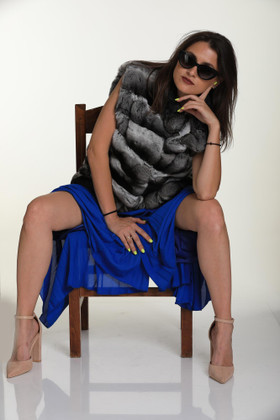
Can I Wear My Fur Coat In The Rain ?
The short answer is yes you can wear any fur coat both in rain and snow but you should avoid getting it soaked .
Fur Is designed by Nature to Repel Water
Fur pelts have guard hair and underfur. The guardhair are the longest hair and are responsible for repelling efficiently water and wind . Underfur is shorter in length and usually higher in density and serves as a heat insulator (that is why sheared or plucked fur coats are still very warm). Shearing and plucking are methods of reducing the volume of a fur coat for aesthetic reasons .
Not All Fur Coats Repel Rain Water The Same
This is largely dependent by the keratin structure of each fur type. Keratin is a protein that is insoluble to water and covers the outer part of the hair making it waterproof. It is also responsible for the sheen of a fur pelt . Some fur types contain more keratin in their hair such as beaver , mink and sable. Remember beaver is an aquatic species. Chinchilla fur coats have a smaller percentage of keratin and although unimaginably supple, they are less water repellent. While a beaver fur coat can take up a greater hit of rain without getting soaked a sheared beaver fur coat's ability is compromised due to the lack of keratin rich guardhair.
The Recovery Of a Soaked Fur Coat Depends on the Skin Type
Preventing a fur coat from getting soaked is one thing and recovery from such an event is another. While all furs can handle rain water in reasonable amounts , not all will tolerate getting soaked in water. This has to do with how elastic and waterproof the skin is and also the processing in the tannery .Lynx , mink , sable and persian lamb are very elastic and waterproof. As fur makers we experience this by first hand during the blocking process (stretching and stapling the pelts on wooden boards so that they fit the design pattern). 'Blocking" involves spraying the skin on the hairless side , so that they become more pliable and the fur types mentioned above are extremely water repellent (the water forms speheres on the surface just like a freshly waxed car). The tanning process involves mechanical and chemical agents that remove the excess fat . A well tanned fur pelt retains its elasticity ,its capability of repelling water , it will shed less (thus keeping the guardhair longer, decades literally) and of course will be in pristine condition for several years . Fur coats such as chinchilla and fox have more delicate skins and require extra care when it comes to getting soaked. I repeat that they can handle and repel water but it is not advisable to be worn when it is raining cats and dogs . Also artifically colored furs are more sensitive and harder to recover if they get soaked.
What Do I Do If My Fur Coat Gets Soaked ?
First of all , you should always give your fur coat a firm shake if it gets wet. This will remove the excess of water over it and the your beloved coat will be fine. Also note that in the beginning of the wearing season (fall or winter depending on your location) it is most likely that you had your coat stored. Inevitably in several cases the fur hair has been pressed down or even "messed" if it was not stored carefully . Make sure before wearing it to have it "refreshed". By refreshing , i mean having it steamed at a fur cleaning service or a professional furrier. This will not only restore the original beauty of the garment but it will also arrange the hair direction in an organised manner that forms a "tile" roof (yes just like the tiles orientation in your roof , the fur pelts hair have got a grain direction and in most cases they are stitched in a way that the grain heads downwards). If you do not have access to a fur cleaning service then a water spray bottle and a fur comb will do the trick. Just remember to dry it up with a hair dryer that is capable of producing room temperature air . Hot air is not good for your fur.
If you find that your garment has absorbed a bit of water you should let it dry naturally in a well ventilated space ,away from the sun or any heat source.
If it is soaked then you should look immediately for a professional furrier . In severe cases where an extended amount of time is anticipated before being able to get the soaked coat to the furrier , a seamstress might save the day. Request to have the inner lining unstitched to the part of the fur that is soaked so that it can be exposed to air and dry faster.
What a Furrier Can Do in Case my Fur Coat is Soaked in Water ?
Well here comes the cavalry to save the day. In several cases the lining will be partially removed so that the wet skin dries faster . In severe cases the part of the fur that cannot be recovered will be cut off and replaced with another . In other cases special hydrating oils may be applied . The sooner you can have your fur inspected the better.
Which Fur Types Are Most Suitable for Rainy Climates And Which Are Less ?
Here is a list of fur types recommended for rainy weather
-Mink fur
-Lynx Fur
-Sable Fur
-Beaver Fur (unsheared-unplucked)
-Coyote fur
-Raccoon fur
-Persian lamb fur
And a list of fur types not recommended to be used in rainy weather
-Chinchilla Fur
-Rabbit Fur
So... Is Rain Really an Issue When Deciding to Buy a Fur Coat ?
If you plan to wear your beloved fur on a frequent basis then my personal opinion is to go for mink that is a champion of durability or a sheared beaver that is the king of comfort and does not break the bank.
The fur industry has evolved and while in the past a fur garment was meant to be worn only in special occassions now there are several fur product levels , reasonably priced that allow for daily use.
Of course the high end furs are luxury items and should be considered as such. A chinchilla fur coat is sensitive and expensive . So is a Ferrari . This does not mean that you leave it hanging inside a garage !
Go ahead and enjoy the ultimate luxury and the unique feel and look that this magic natural product has to offer !
If you have any questions feel free to contact us
Edited by neoncossak
-
 2
2
-
 1
1




(Custom).thumb.png.d903fc6b9cf2547f8bfc45580322bd48.png)